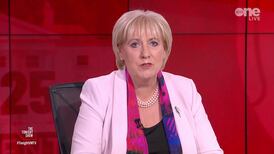Mr John Wilson, the Government nominee on the independent commission set up to oversee the recovery of the bodies of the people killed by the IRA, is to press for the identification of the burial places of five others not included on the list passed to the authorities.
Six sites in Counties Louth, Monaghan, Meath and Wicklow were identified to the Independent Commission for the Location of Victims' Remains at the weekend. Gardai suspended search operations last night without finding any remains of the eight people reported to be buried in these sites, and will resume early today.
The commission has been informed that the body of Jean McConville, a mother of nine who was abducted from her home in Belfast in 1972, is buried under a public carpark at Templeton Beach, five miles from Carlingford, Co Louth. Extensive excavation work took place at the car-park yesterday, but nothing was found.
The remains of John McClory and Brian McKinney - aged 17 and 23 respectively when they were abducted and murdered by the IRA - are said to have been buried together in bogland at Colgagh, Co Monaghan, across the Border from the Co Armagh village of Cullaville. Columba McVeigh's body is stated to be buried in similar terrain at Carrigroe, near Emyvale, in Co Monaghan.
The remains of Kevin McKee and Seamus Wright are thought to be in a double grave in Coghalstown Wood, about five miles north of Navan. The remains of Brendan Magrew are believed to be in Oristown Bog, about four miles from Kells.
Danny McIllhone's body is thought to be buried in mountainous terrain near the village of Lacken, in west Wicklow.
It is understood the sites were identified to Father Alex Reid and a fellow Redemptorist priest by the IRA last Friday, and they then passed the information to an official working with the commission.
Forensic examination of the remains found in Faughart cemetery, just inside the border in Co Louth, on Friday morning is continuing this week to establish if they are those of Eamonn Molloy, from Belfast, who was killed in the mid-1970s. It is believed Mr Molloy's body may have been buried in Northern Ireland, and that rather than disclose a location, the IRA chose to disinter the remains and move them south of the Border.
In a statement, the joint chairmen of the independent commission, the former Tanaiste, Mr Wilson, and the former head of the Northern Ireland Civil Service, Sir Kenneth Bloomfield, urged the media to respect the privacy of the families while the digging was taking place.
Although there has been no admission from the IRA, it is believed it was also responsible for the abduction, murder and secret burial of at least five more people. These are John McIlroy, who disappeared from Andersonstown in west Belfast in 1974; Charles Armstrong and Gerard Evans, both from Crossmaglen, Co Armagh, who disappeared in 1979 and 1980; Sean Murphy, from Cregganduff, Co Armagh; and Robert Nairac, the soldier who was killed in 1977.
It is not clear why the IRA has not revealed what happened to these victims, but Garda sources suggest there has been a difference of opinion between the IRA in south Armagh and its Belfast-based leadership over disclosing the whereabouts of the bodies.
Mr Wilson has signalled he will continue to press for the release of information about the remains of these missing men and also for details from the splinter republican group, the Irish National Liberation Army (INLA), about the whereabouts of a Newry man, Seamus Ruddy, who was killed by his associates in Paris in 1986.
Earlier this year the INLA provided maps and a video of where it said Mr Ruddy was buried. The site was excavated by French police but nothing was found.
In spite of speculation at the weekend that the IRA's decision to reveal the whereabouts of nine of its victims might signal its intention to call off its campaign permanently, senior Government sources said there was no anticipation that the IRA was preparing to decommission any of its weapons or to issue any statement along the lines that the "war is over".





